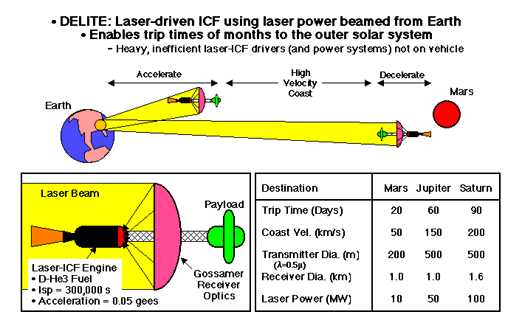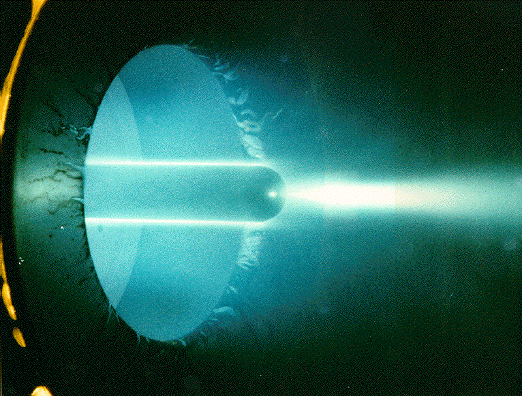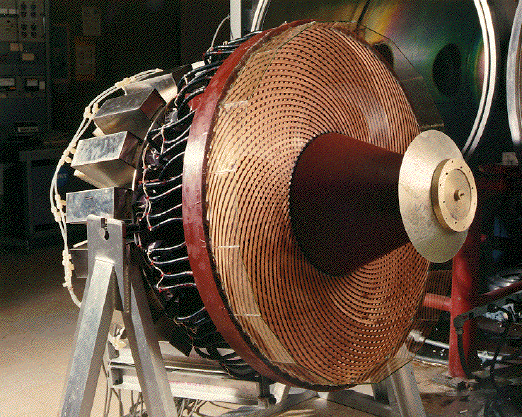Knowledge = power
Power = energy
Energy = matter
Matter = mass
Mass distorts space,
Therefore, the vehicle to unlimited travel
Is a library.
-Terry Pratchett
There are many different ways to propel a ship through space. They divide in to three main categories: Chemical, Nuclear, and Electric. I donít have statistics for all the rockets, but, Iíll put down the ones I have. They vary in different designs, so the numbers might not be exact. Some of the engines currently only exsist as small experimental things, the stats may change drastically as they are scaled up. These are very very general examples, if you want more specific stuff or to see where we got all of the really cool pictures, go to the NASA Advanced Propulsion Concepts site.
Nuclear Thermal: This drive is made by running a stream of gas (usually hydrogen) through a nuclear reactor. The gas is heated to very high temperatures, and expands very quickly through the rear of the engine. Basically a nuclear steam engine. This engine has a great deal of advantages from its MASSIVE amount of thrust, but can't be used anywhere near a planet or asteroid, where we'll be for a while in this trip.

Thrust: about 65,000 Newtons
Isp: 1000-8,000
Fuel: hydrogen, uranium/plutonium
Pros: Simple, powerful, efficient
Cons: Radioactive, nuclear fuel is rare, reactor can be dangerous
Raw Nuclear: This is basically a nuclear reactor where the heat and radiation are directed out the back. Itís kind of iffy; since heat and radiation have no mass I canít see how it would work, but apparently it does. It could possibly work like a super powerful chemical rocket, because whatever's in the path of that heat is going to expand. Then again, we don't know how it might work. Things Happen.
An alternative is nuclear fusion, which smashes two atoms together until they form one atom. This releases even more power, but takes massive amounts of energy. So far, scientists have not managed to create a fusion reaction that produces more energy than it takes. But, I donít see that thatís necessary for a rocket, you could include a small nuclear plant to take up the excess power. It is theoretically way more powerful as fission. There are still all kinds of design problems, though. For the sake of so-called realism, I won't consider nuclear fusion a short-term option.
Laser-Powered Fusion: Here's some news that I recently received from IceFoX:
You've probably heard of the idea of using a
series of lasers to compress a pellet of deuturium and tritium or
Helium-3, and thus start a fusion reaction, for either energy or space
propulsion. The problem with this is it's hard to make the fusion reaction
generate enough electricity to power the lasers. Well, the picture(see below)
demonstrates using beamed energy from a distant source to counter this. The
laser is fired from some orbital installation with lotsa solar
collectors of one kind or another, and it is either used to generate
electricity on the ship or more ideally reflected in to the fusion chamber to
sustain the reaction. This solves lotsa problems. Since the lasers don't
have to move, they can be made as big and powerful as necessary, and
the fusion reaction doesn't have to produce much, or any, electricity.
True, you need a pretty darn big receiver for the laser, but that's just
possible, and it's way smaller than anything needed for a solar sail." 
Thrust: (completely wild guess) 1,000,000 (??)
Isp: 300,000
Fuel: deuterium, helium3, lasers @10+ megawatts
Pros: extremely quick transit time to lots of places, uses little power, easy to construct, easy to fuel, etc.
Cons: really big, unwieldy, has to move in a pretty much perfectly straight line, fabric is likely to rupture if the ship hits anything, etc.
Ion drive: Ion drives consist of a chamber with two electrically charged grids inside, which are charged. An electron gun, such as the ones in TV and computer screens, ionizes the fuel which is then pulled through the grids by the electric charge. There are many different kinds of ion drives, using different kinds of fuels and with different performances.
Thrust: 0.05-30 Newtons
Isp: 2000-10,000
Fuel: hydrogen, cesium, xenon, argon (one of those, not all), electricity
Pros: Small, simple, efficient
Cons: May not be able to be scaled up to very large sizes, low thrust
Hall-effect Drive: Is similar to an Ion Drive in principle, but uses a ring of magnets to accelerate the ions instead of charged grids.
Thrust: 0.05-30 Newtons
Isp:1500-4500
Fuel: xenon, electricity
Pros: easier to scale up than ion drive
Cons: less efficient
Magnetoplasmadynamic (MPD): I like this one the best, it can be both very powerful (comparitivly) and very efficient. It uses an electric current to ionize the fuel, then the interaction of the current and a magnetic field pushes it out the back. The main problem is the corrosion of the electromagnets, which become very hot.

Thrust: 30-200 Newtons
Isp: 1000-11,000
Fuel: argon, lithium, hydrogen, electricity
Pros: one of the most powerful electrical engines
Cons: usually less efficient than the ion drive
Pulse-inductive thruster (PIT): This one is potentially very efficient. It jets gas on to a spiral grid, then sends a powerful charge through it which simultaniously ionizes the gas and creates a magnetic field that pushes it away. One of the advantages of this is it doesn't use electrodes, which tend to wear away over time. Another is it can use just about any kind of gaseous fuel with high efficiency

Thrust: 20 Newtons
Isp:8000?
Fuel:argon, electricity
Pros: No electrodes, efficient
Cons: Low thrust, less developed
Variable Specific Impulse Magnetoplasma Rocket (VASIMR): A bit like the MPD rocket, but it has three parts. The first is basically the same as a MPD engine, the second uses radio waves to compress plasma, make it spiral and heat it up. The third part uses a magnetic "choke" to change the amount of gas leaving, from high thrust and low efficiency to low thrust and high efficiency. It can make much more thrust than any other electric engine, at a sacrifice of efficiency.
Thrust: 30-1500 Newtons
Isp: variable (read the name), I'm not quite sure of the range
Fuel: hydrogen
Pros: can provide both high and low thrust
Cons: complicated, wouldn't like to be near one if it messed up
Back to technology page.